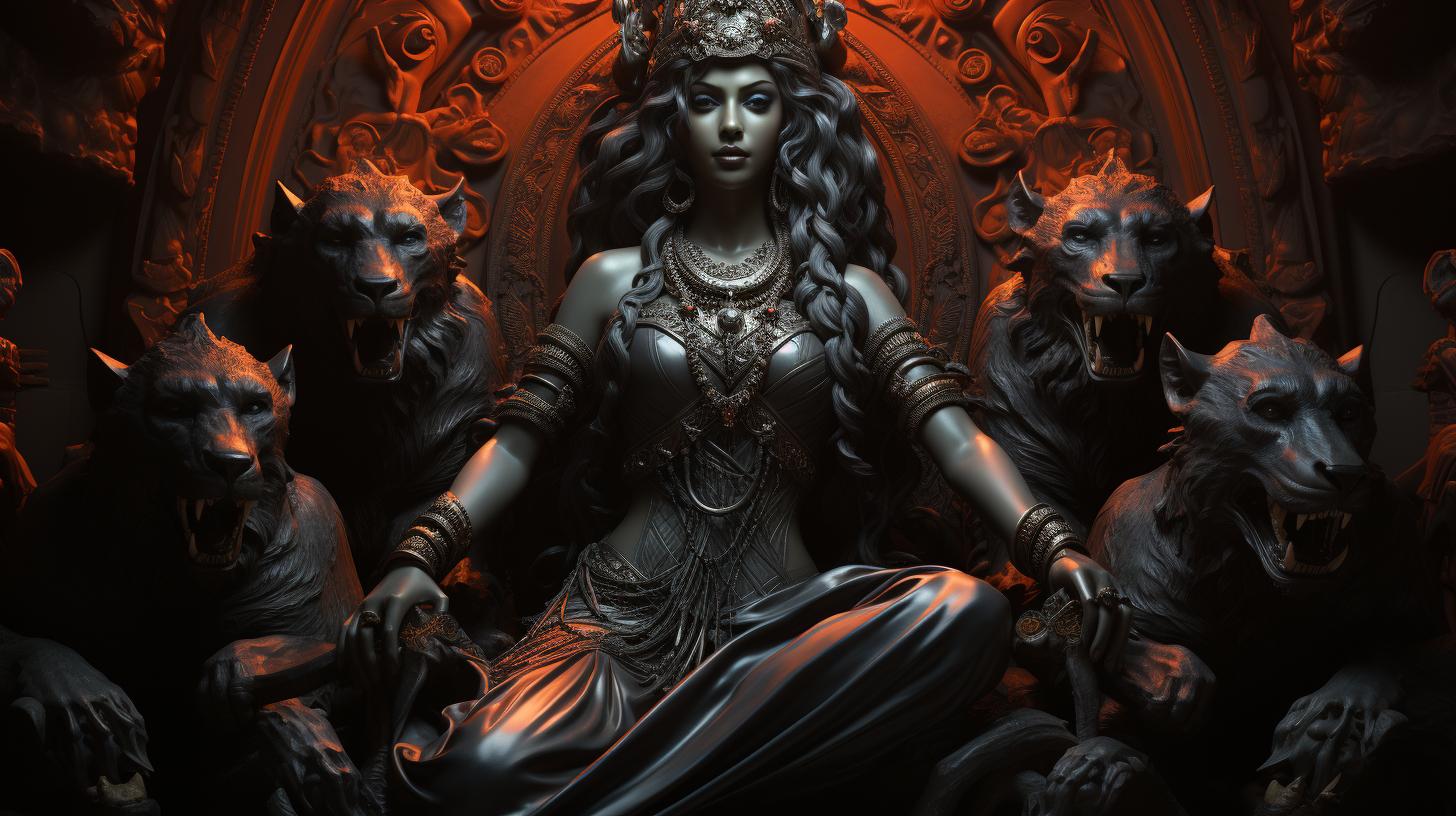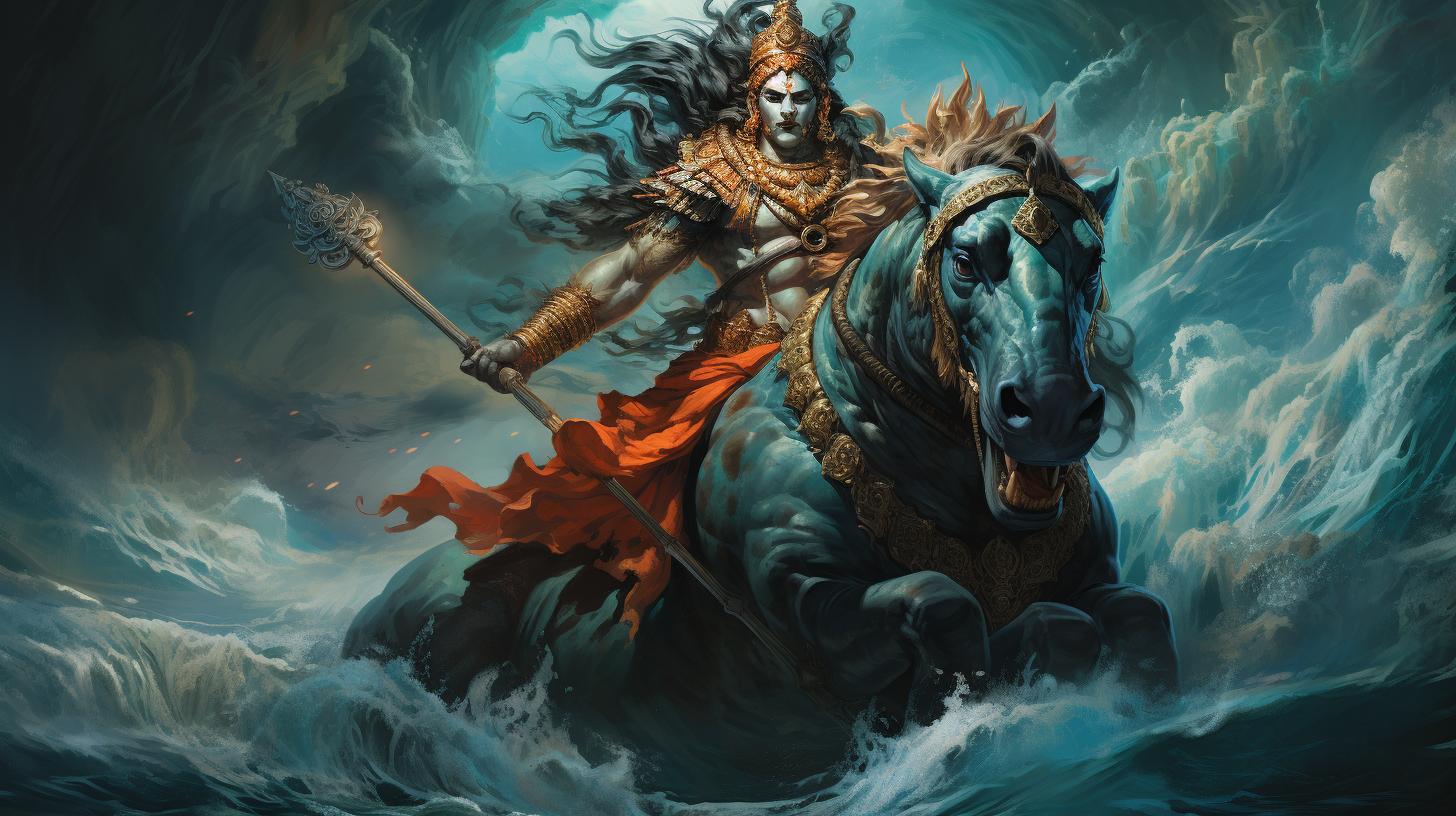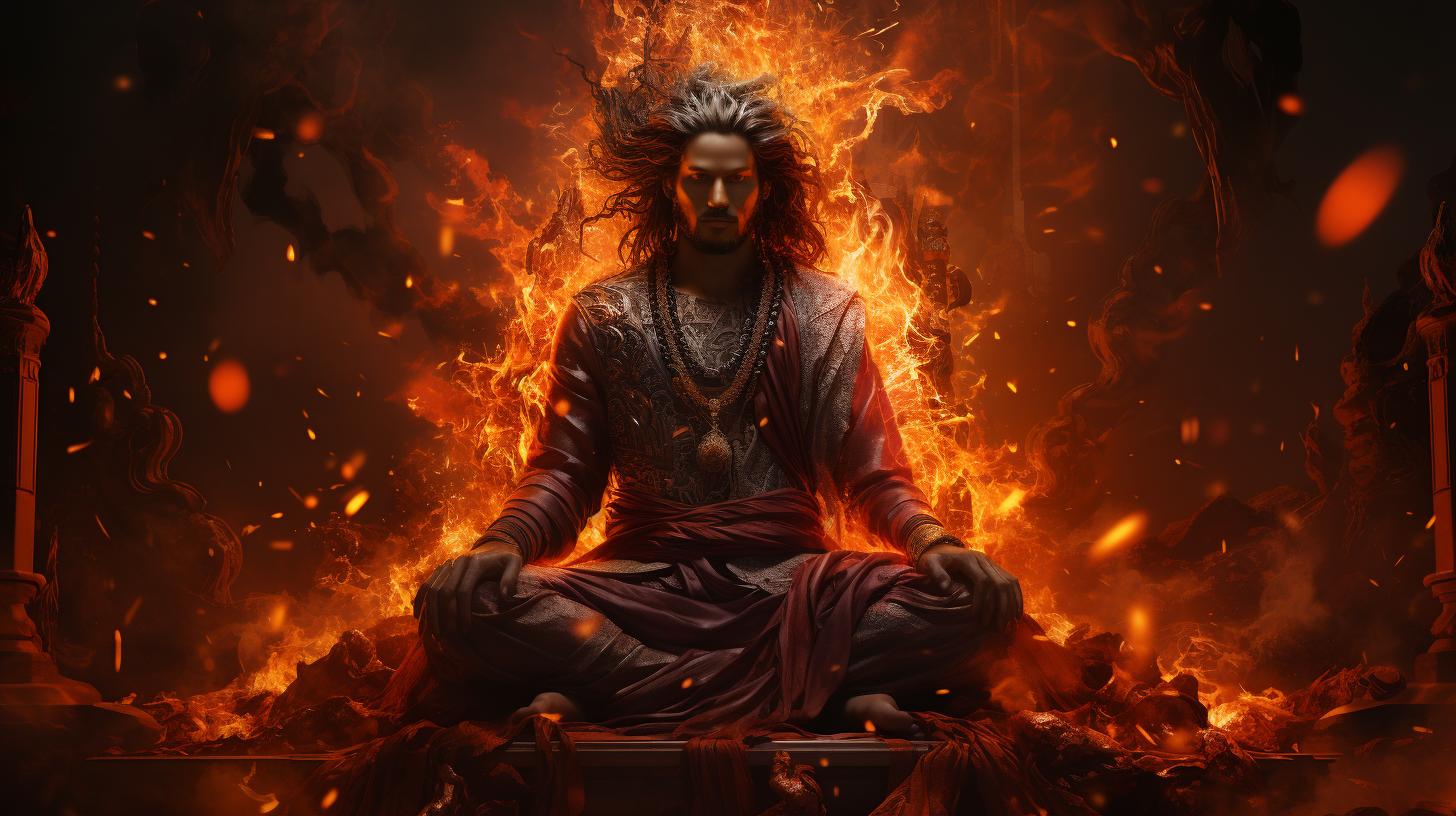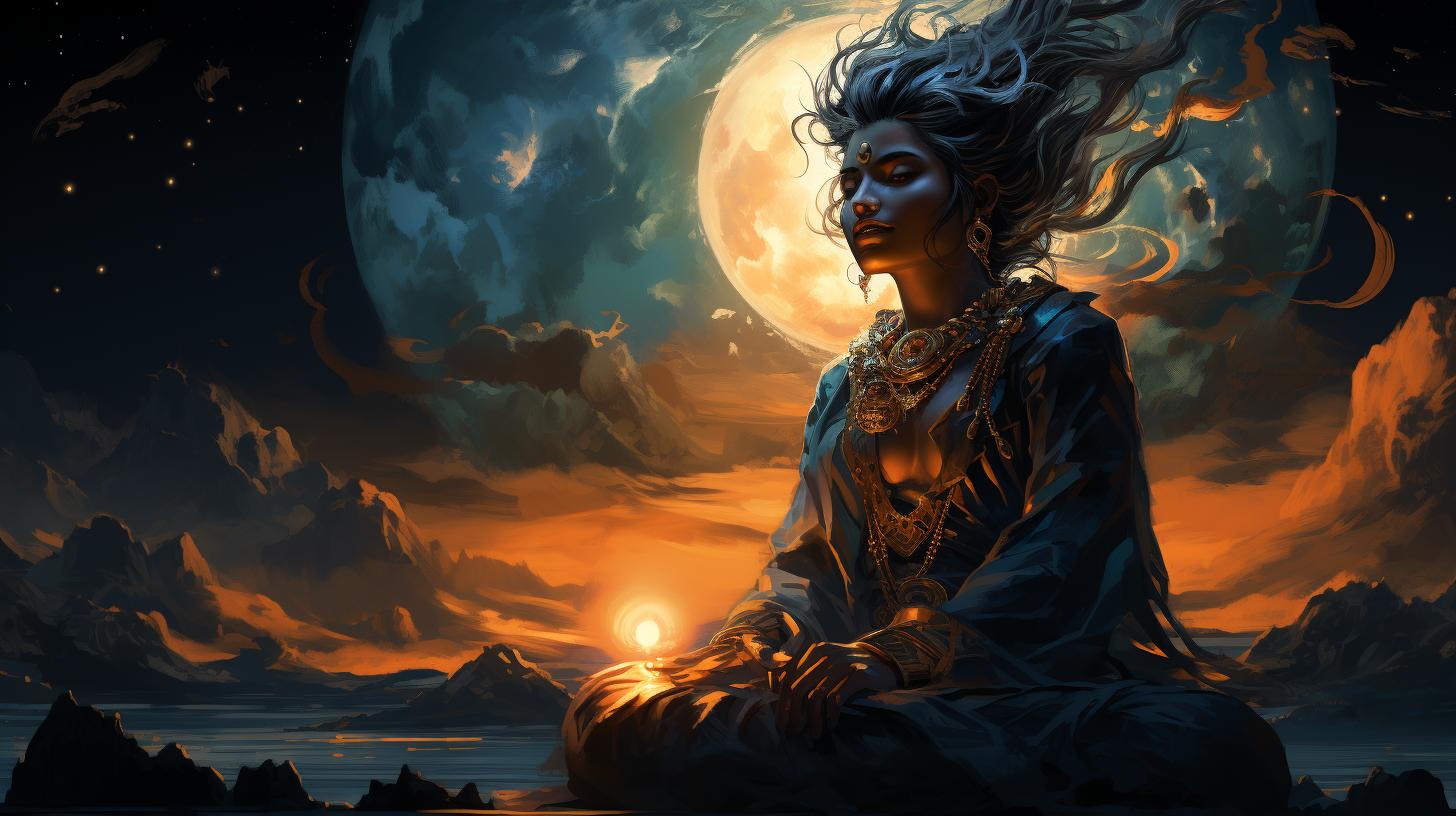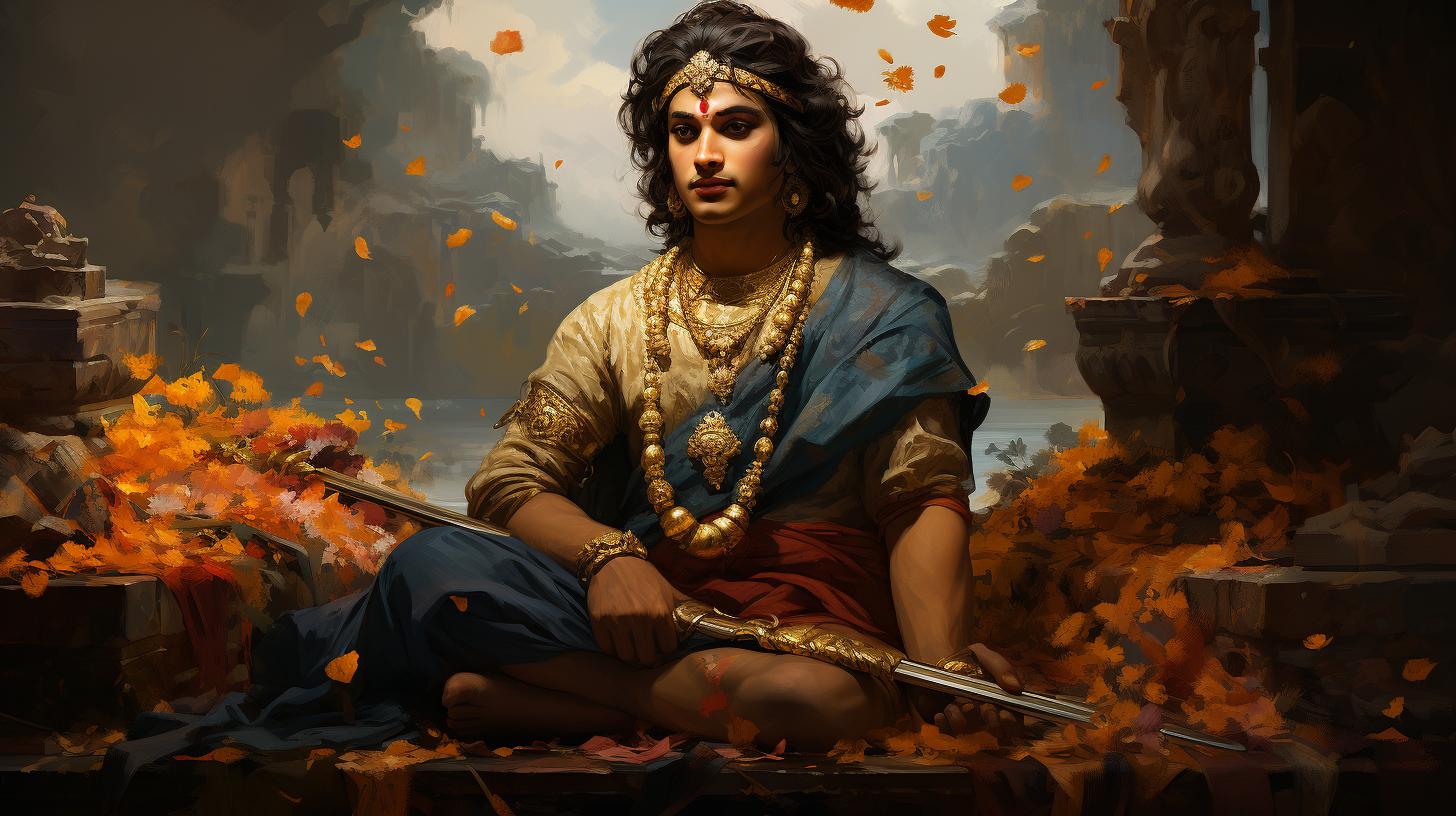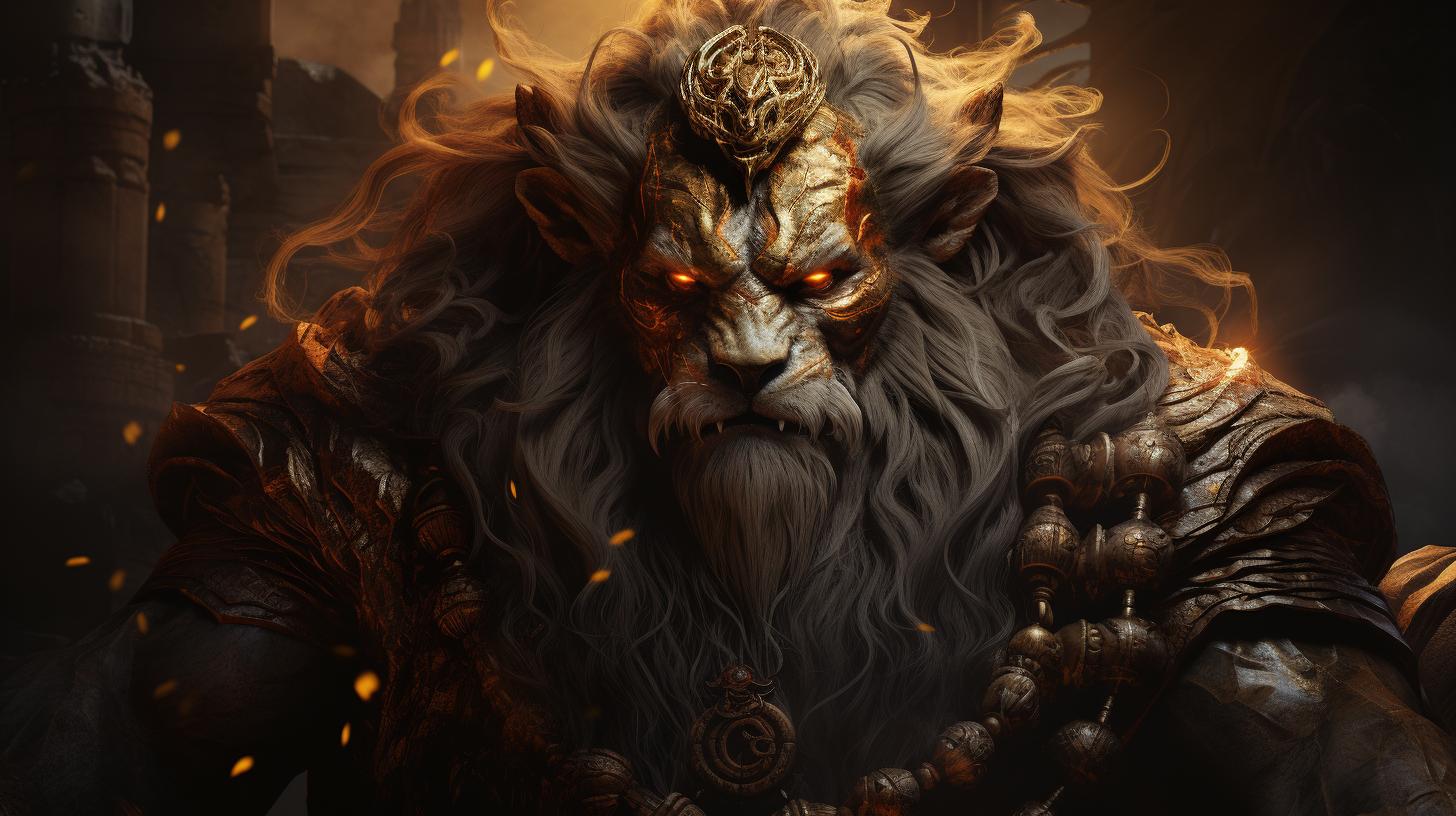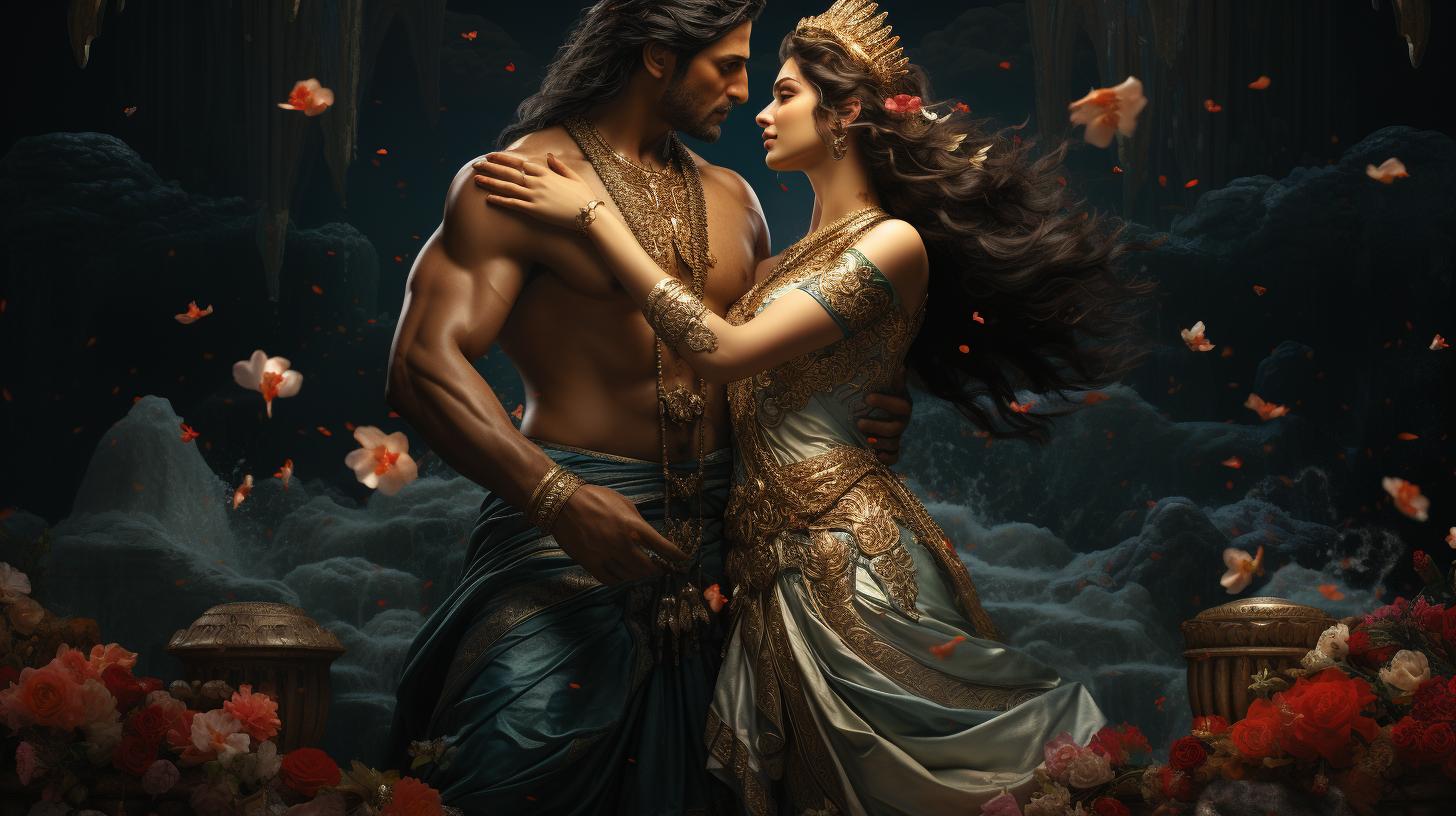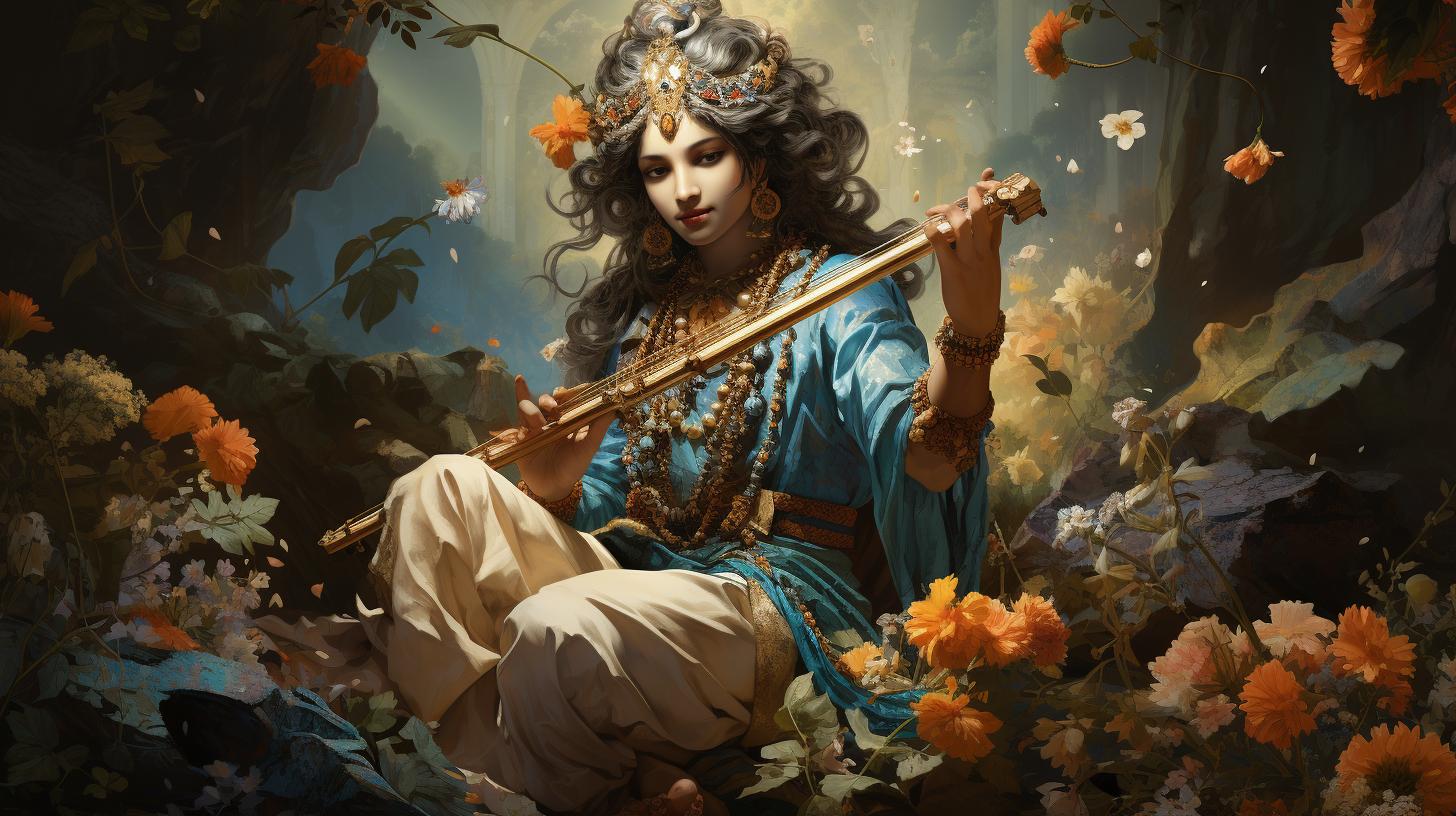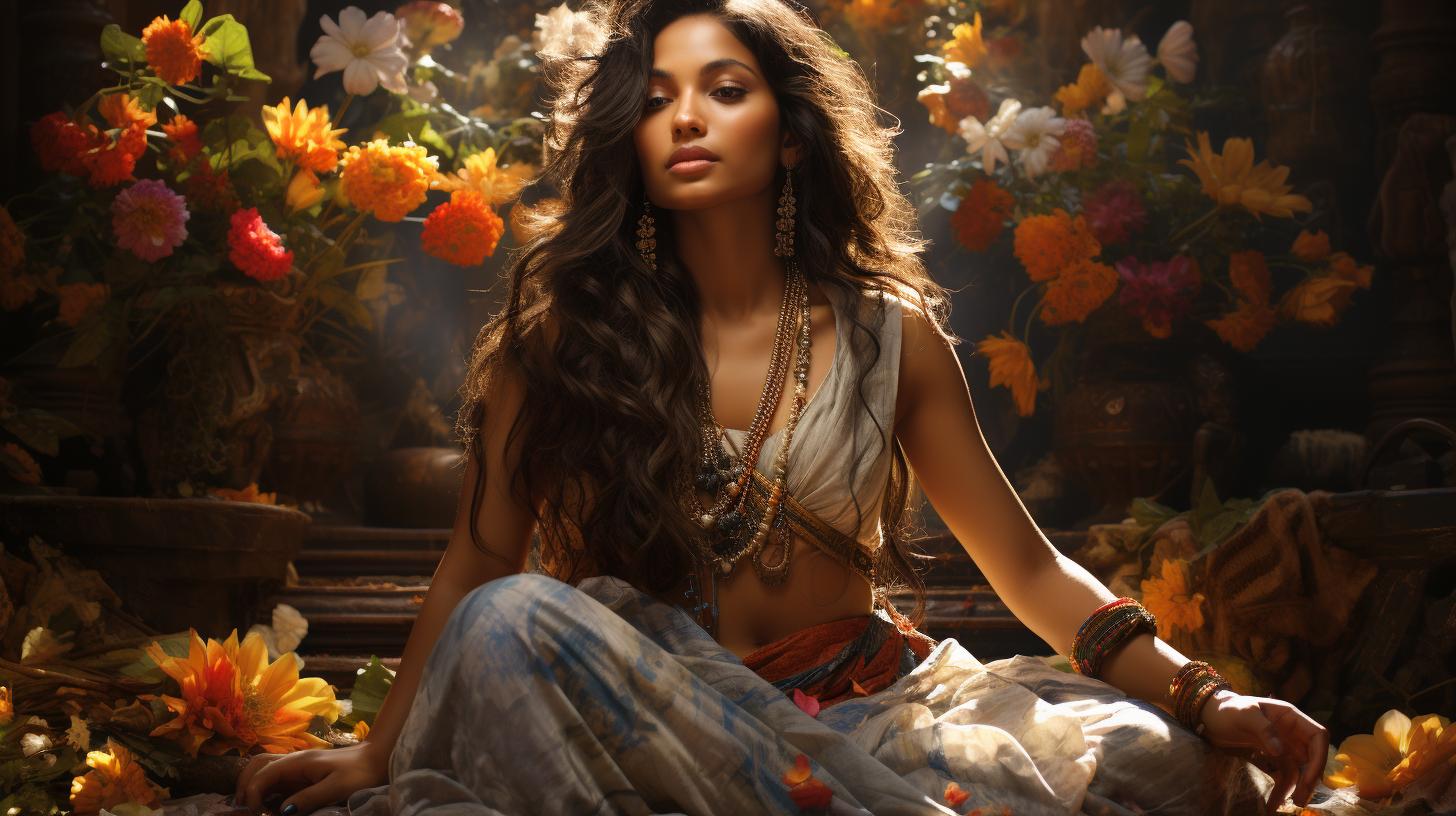Kali the Indian Goddess of Death: Unveiling the Mysteries of a Powerful Hindu Deity
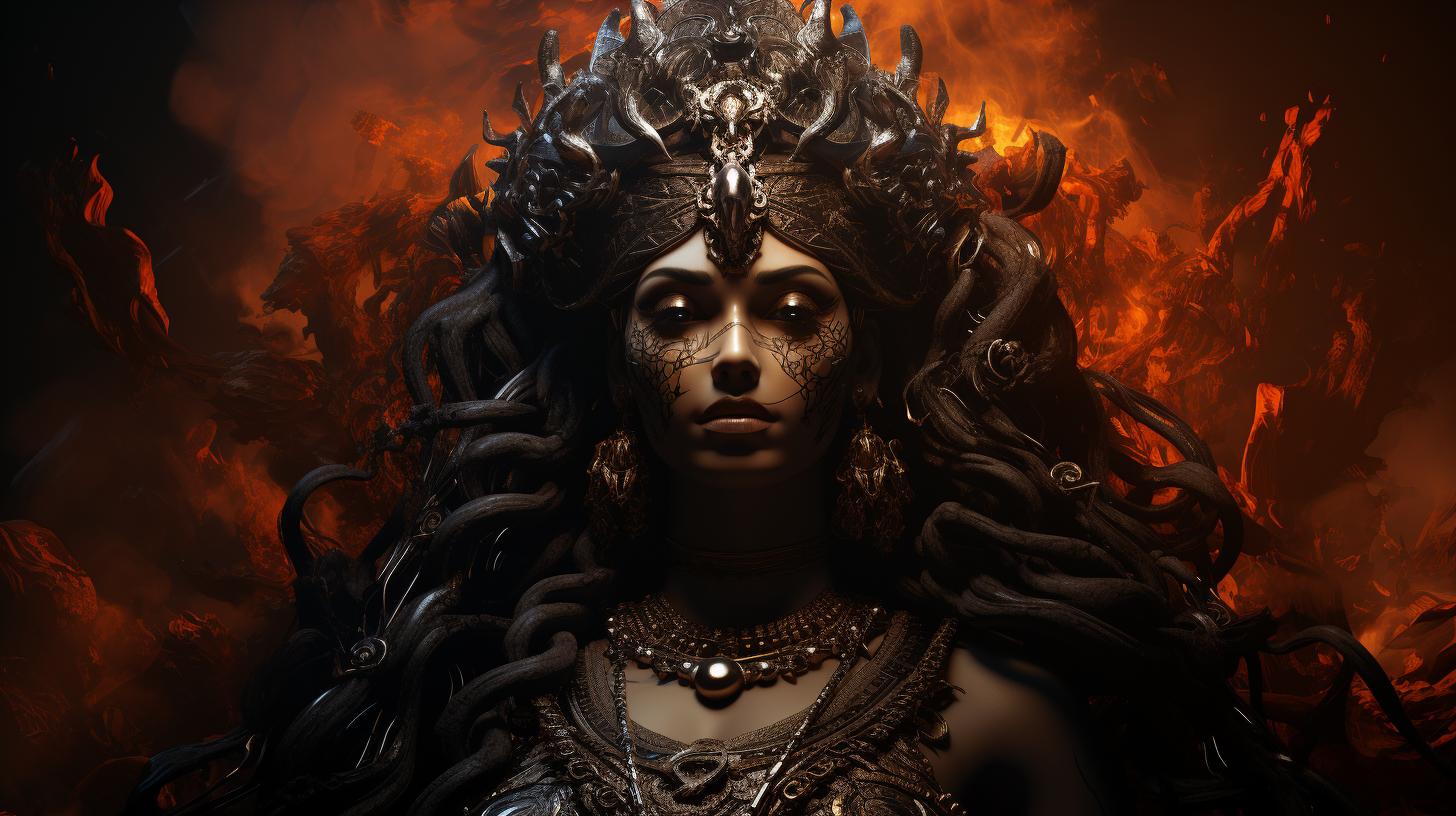
Kali, the Indian Goddess of Death, holds a significant position in Hindu mythology and is associated with time, power, and destruction. Known by various names like Kalika and Kali Mata, she is worshipped in India and regions of South Asia.
Represented with blue or black skin, multiple arms, and a necklace of decapitated heads, Kali’s presence extends from ancient scriptures to contemporary art. This article explores her origins, symbolism, relationship with Shiva, worship rituals, and her impact in both Eastern and Western cultures.
It delves into her enigmatic role as a transformative and protective deity.
The Mythological Origins of Kali: Exploring her Connection with Hindu Deities
Kali, the enigmatic goddess of death and destruction, holds a prominent position in Hindu mythology. Her origins can be traced back to ancient texts and scriptures, where she is often depicted as an integral part of the divine pantheon.
Exploring her connection with other prominent Hindu deities sheds light on the intricate mythology surrounding Kali.
According to traditional Hindu narratives, Kali is believed to have emerged from the fierce battle between the gods and demons. As the gods faced overwhelming opposition, they called upon the warrior goddess, Durga, to aid them.
It is during this battle that Kali, an embodiment of Durga’s wrathful aspects, manifests herself as a separate entity. Her emergence marked a pivotal moment in Hindu mythology, representing a powerful force capable of annihilating evil.
Kali’s connection with other deities, such as Shiva and Parvati, further enhances her mythological significance. In Hindu mythology, she is often portrayed as the consort of Shiva, the destroyer and transformer of the universe.
Together, Kali and Shiva embody the paradoxical nature of creation through destruction. Their cosmic dance symbolizes the eternal cycle of life, death, and rebirth.
Additionally, Kali’s association with other goddesses like Parvati, Saraswati, and Lakshmi highlights her multifaceted character. She represents the fierce, untamed aspect of divinity, in stark contrast to the gentle and nurturing depictions of other goddesses.
Kali’s unique role as a primordial force of destruction and transformation sets her apart in the pantheon of Hindu deities.
Exploring the mythological origins of Kali unveils the intricate web of connections she shares with various Hindu deities. Her emergence from the battle between gods and demons, her association with Shiva and other goddesses, all contribute to her complex character and significance within Hindu mythology.
Understanding these origins provides a deeper appreciation for the multifaceted nature of Kali, the Indian Goddess of Death.
Iconography of Kali: Depicting the Goddess of Death and Destruction
In the vibrant world of Hindu mythology, Kali, the Indian Goddess of Death, is visually represented with a unique iconography that captures her powerful and fearsome nature. The depictions of Kali vary in different artistic forms, but there are certain common elements that consistently symbolize her essence.
First and foremost, Kali is often portrayed with skin that is either blue or black, symbolizing her association with the darkness and the night. This signifies her role as the destroyer of illusions and ignorance.
Her nakedness represents her transcendence of societal norms and her connection with primal energy. Kali’s extraordinary appearance commands attention and reflects her fierce and unapologetic nature.
One of the most striking features of Kali is her multiple arms, typically depicted as four to ten arms.
These arms symbolize her immense power, as they enable her to perform multiple actions simultaneously. Each hand carries a specific weapon or object, such as a sword, a trident, a severed head, or a bowl for collecting blood.
These objects represent her ability to destroy evil forces and restore balance.
Another significant element of Kali’s iconography is her long protruding tongue. This tongue represents her insatiable thirst for the life force and her ferocious appetite for destruction.
It also serves as a reminder that life and death are interconnected, as she consumes both positive and negative energies.
Kali is often depicted wearing a skirt or belt made of human arms or hands, symbolizing her victory over ego and attachment.
This powerful image signifies her ability to liberate individuals from their earthly desires and attachments, leading them towards spiritual enlightenment.
Additionally, Kali is portrayed wearing a necklace of severed heads, signifying her triumph over ignorance and ego-based identities.
These decapitated heads represent the destruction of the limited sense of self and the awakening of higher consciousness.
Lastly, Kali is frequently depicted standing or dancing on her consort, Shiva. This represents their cosmic union, where Kali harnesses Shiva’s stabilizing energy while embodying her own dynamic and transformative power.
This portrayal symbolizes the inseparable connection between creation and destruction.
The iconography of Kali is not merely artistic expression; it carries deep symbolic significance. Through her unique visual representation, Kali invokes a sense of awe, fear, and reverence, ultimately reminding us of the eternal cycles of creation and destruction that exist within the cosmic order.
The Significance of Kali’s Name: Understanding the Symbolism of ‘Kālá’
One of the most intriguing aspects of Kali, the Indian Goddess of Death, lies in the significance of her name. Derived from the Sanskrit word ‘kālá’ meaning ‘time’, her name conveys profound symbolism that extends beyond temporal notions.
In Hindu mythology, time is often associated with creation and destruction, and Kali embodies this duality in her multifaceted nature.
The name ‘Kālá’ serves as a reminder of the cyclical nature of existence, encompassing birth, life, death, and rebirth. Kali’s association with time signifies her role as a transformative force that brings about change, both destructive and creative, in the cosmic order of things.
Furthermore, ‘Kālá’ represents the eternal and timeless aspects of the universe. Kali, as the Goddess of Death, transcends the boundaries of ordinary mortals and symbolizes the eternal cycle of life and death.
Her name evokes the concept of impermanence, reminding us of the transient nature of all things and the inevitable passage of time.
Beyond its connection to time, the name ‘Kālá’ also carries associations with power and darkness. Kali’s formidable presence and fearsome appearance reflect her ability to confront and vanquish the forces of evil and ignorance.
Her name encapsulates her role as a divine protector, as she annihilates negativity and purifies the world through her transformative power.
In summary, the significance of Kali’s name lies in its multifaceted symbolism related to time, transformation, power, and protection. It serves as a potent reminder of the cyclical nature of existence, the eternal essence of the universe, and the fearsome yet transformative nature of the Indian Goddess of Death.
Kali in Hindu Scriptures: Her Role in Mythological Tales and Epics
Within Hindu scriptures and sacred texts, Kali is a prominent figure, portrayed in various mythological tales and epics. These ancient narratives shed light on her multifaceted role and symbolize her position as a force of both destruction and protection.
One such tale is the battle against the formidable asuras Madhu-Kaitabha. In this epic confrontation, the gods sought the assistance of Kali, who emerged from the fierce wrath of Goddess Durga. With her immense power and divine weapons, Kali demolished the asuras, ensuring the triumph of good over evil.
Kali’s encounters with the demon Daruka are also noteworthy. According to legend, Daruka had unleashed chaos and turmoil upon the world. The gods once again turned to Kali, who, with her relentless strength and warrior-like demeanor, battled and vanquished Daruka, restoring peace and order.
These mythological tales not only depict Kali as a fierce warrior but also highlight her unwavering commitment to righteousness. She is revered as a guardian and protector, summoned in times of crisis to annihilate evil and restore harmony.
Moreover, Kali’s presence in Hindu epics serves to emphasize the cycle of life and death. She represents the impermanence of all things, reminding humanity of the transient nature of existence. Through her destructive powers, Kali ensures the necessary destruction of old structures, paving the way for rejuvenation and renewal.
In Hindu scriptures, Kali also symbolizes the fierce aspect of the divine feminine. Her portrayal as a formidable goddess challenges societal norms and redefines conventional notions of power and strength. She dares to defy traditional gender roles, embodying feminine potency and fearlessness.
Overall, the mythological tales and epics in Hindu scriptures illuminating Kali’s role provide profound insights into her significance as a goddess of transformation, destruction, and protection. Through these narratives, her complex nature emerges, inspiring devotees to embrace the paradoxes of life and find strength in the face of adversity.
Kali and Shiva: Unraveling the Cosmic Dance of Destruction and Creation
One of the most profound aspects of Kali’s mythology is her unique and intricate relationship with Lord Shiva. As the ultimate representation of destruction and creation, Kali and Shiva engage in a cosmic dance that embodies the eternal cycle of life, death, and rebirth.
Shiva, the deity known as the Destroyer, is often depicted as her consort, symbolizing their inseparable connection. This divine partnership represents the complementary forces of destruction and creation, with Kali embodying the primal energy of Shakti and Shiva embodying the pure consciousness.
Together, Kali and Shiva engage in a dynamic interplay of power and transformation. Kali’s fierce and unrelenting nature complements Shiva’s calm and detached demeanor. While Kali represents the raw, untamed energy of destruction, Shiva tempers it with his serene presence, bringing harmony to the cosmic dance.
Their dance symbolizes the continuous cycle of life, where destruction paves the way for creation and creation leads to eventual destruction. Kali’s role is to initiate the process of destruction, clearing the way for new beginnings.
It is through this dance that the universe evolves and transforms.
The relationship between Kali and Shiva is not only symbolic but also deeply spiritual. It teaches us the importance of embracing both the light and dark aspects of existence, acknowledging that destruction is an integral part of creation.
By understanding and accepting this dance, we can find balance and harmony within ourselves and in the world around us.
Kali Puja and Worship: Rituals and Festivals Dedicated to the Dark Mother
Kali Puja, also known as Shyama Puja or Mahanisha Puja, is a significant ritual and festival dedicated to the revered goddess Kali.
This annual celebration takes place during the Hindu month of Kartik, typically falling in October or November. It is particularly popular in the regions of Bengal, Assam, and Odisha, where fervent devotees observe elaborate ceremonies and vibrant festivities.
During Kali Puja, devotees gather in temples and homes, intricately decorating altars with flowers, lights, and the image of Kali. The goddess is honored through various rituals and offerings, symbolizing devotion and seeking her blessings.
Traditional ceremonies involve chanting of sacred mantras, recitation of hymns, and performing aartis (ritualistic waving of lamps) to invoke Kali’s divine presence.
One of the distinctive features of Kali Puja is the sacrificial offering of animals, particularly goats, as a symbolic gesture to appease the goddess and ward off evil forces.
While the practice may be disconcerting to some, it is essential to understand the ritualistic significance within the cultural context. The sacrifice represents the idea of surrendering one’s ego and desires, offering them to Kali as an act of devotion.
The festival of Kali Puja is characterized by mesmerizing cultural performances, including dance, drama, and music, showcasing the grandeur of Indian art forms. It is an occasion of enthusiasm and joy, bringing communities together to celebrate the presence and power of the dark mother goddess.
Apart from Kali Puja, there are other festivals dedicated to Kali celebrated throughout the year, such as Navratri and Diwali. Navratri, meaning “nine nights,” is a Hindu festival honoring the nine forms of the goddess, including Kali.
Devotees observe fasting, engage in devotional practices, and perform traditional dances like Garba and Dandiya. Diwali, the festival of lights, also commemorates Kali’s triumph over evil, and devotees illuminate their homes with lamps to invite her divine blessings.
The worship of Kali through these festivals not only emphasizes the power and protection she embodies but also serves as an avenue for devotees to seek spiritual transformation and divine grace.
It is a reminder of the eternal cycle of life and death, and the need to embrace the darker aspects of existence for personal growth and liberation.
Kali in Tantric Practices: Exploring her Role in Hindu Tantra
Hindu Tantra, a spiritual and ritualistic tradition rooted in ancient India, holds a significant place for the worship and exploration of Kali, the Indian Goddess of Death.
Within the realm of Tantra, Kali is revered as the embodiment of raw feminine power, representing both the destructive and transformative forces of the universe.
In Tantric practices, Kali is often seen as the ultimate symbol of Shakti or divine energy.
She is worshipped through various rituals, chants, and meditative practices, focusing on invoking her presence and tapping into her immense power. Tantric practitioners seek to merge their consciousness with Kali’s fierce energy, aiming for spiritual awakening and liberation.
One of the key aspects of Kali’s role in Tantra is her association with the Kundalini energy, believed to be dormant within every individual. Through ritualistic practices and meditation, Tantra seeks to awaken this dormant energy, allowing it to rise through the different chakras of the body, ultimately leading to spiritual enlightenment.
Within Tantric circles, Kali is often depicted in her transformative form, adorned with symbolic elements such as skulls, severed heads, and a belt of human arms. These symbols represent the detachment from the material world and the ego, allowing devotees to transcend their limitations and merge with the divine energy.
Furthermore, Kali’s fierce nature in Tantra is believed to have the power to annihilate the ego and dissolve the barriers between the individual self and the cosmic consciousness. This dissolution is seen as a path towards self-realization and liberation.
Through Tantric practices, devotees seek to embrace and integrate Kali’s intense energy within themselves, recognizing her as the catalyst for profound transformation and spiritual growth. In this exploration, the devotee confronts their own fears, desires, and limitations, with the belief that by surrendering to Kali’s power, they will attain liberation from the cycle of birth and death.
Overall, Kali’s role in Hindu Tantra is multifaceted, representing both the destructive and transformative aspects of existence. Through Tantric practices, devotees aim to harness her immense power, confront their own limitations, and merge with the divine energy, ultimately seeking spiritual liberation and enlightenment.
Kali’s Influence in Indian Art and Culture: From Paintings to Sculptures
Kali, the Indian Goddess of Death, has left an indelible mark on the artistic and cultural landscape of India. Her portrayal in paintings and sculptures showcases the rich symbolism and mystical allure surrounding her divine presence.
Artists throughout history have been captivated by Kali’s fierce yet awe-inspiring form, depicting her with meticulous attention to detail and profound symbolism.
In Indian paintings, Kali is often depicted in her iconic blue or black complexion, standing over Shiva, her consort, or engaged in her destructive dance known as the Tandava.
With her multiple arms and a garland of skulls around her neck, she personifies the cosmic forces of creation and destruction. These vivid and vibrant portrayals reflect both the power and grace of the goddess, drawing viewers into the enigmatic world of Kali.
Sculptures dedicated to Kali further amplify her presence in Indian art and culture. Intricately carved images of the goddess can be found adorning temple walls across India, with every curve and expression capturing her divine energy.
Sculptors skillfully bring out the nuances of Kali’s form, showcasing her fearsome appearance while also conveying her protective and nurturing aspects. From the intensity of her eyes to the intricate details of her clothing and jewelry, each sculpture serves as a visual testament to the devotion and reverence accorded to Kali.
One of the most famous sculptures depicting Kali is the iconic statue at the Dakshineswar Kali Temple in Kolkata, West Bengal. This statue showcases Kali in her triumphant and majestic form, evoking a sense of awe and reverence among devotees and art enthusiasts alike.
The imagery of Kali in sculptures not only serves as a medium of worship but also inspires contemplation and reflection on the cyclical nature of life, death, and rebirth.
Through paintings and sculptures, Kali’s influence on Indian art and culture becomes evident.
Her dynamic form and profound symbolism continue to inspire artists and evoke a sense of spirituality in those who encounter her image. The depiction of Kali in these diverse artistic mediums not only reinforces her significance in Hindu mythology but also highlights her timeless relevance and enduring appeal in contemporary times.
The Worship of Kali Beyond India: Her Presence in Nepal, Kashmir, and Bengal
Kali, the powerful Hindu goddess of death, is not only revered in India but also holds a significant presence in other regions of South Asia. In Nepal, Kali is worshipped with great devotion, and she is considered a protector against evil forces.
The people of Nepal celebrate various festivals dedicated to Kali, such as Dashain and Navaratri, where they express their deep reverence through elaborate rituals and prayers.
- In the Kashmir region, Kali is known as Sharika Devi, an important deity in the local folklore.
Legends speak of her fierce battles against demonic forces and her role in protecting the land and its people. The Sharika Devi Temple in Srinagar is a prominent pilgrimage site where devotees gather to offer their respects and seek divine blessings.
- Bengal, particularly West Bengal, holds a profound connection with the worship of Kali.
The annual festival of Kali Puja, also known as Diwali, is a grand celebration where the streets come alive with vibrant decorations, fireworks, and cultural performances. During this time, devotees offer prayers, perform traditional dances, and engage in devotional songs, expressing their devotion towards the fierce goddess.
It is noteworthy to mention that Kali’s presence extends beyond these regions, resonating with devotees who recognize her power, protection, and transformative nature.
Her worship in Nepal, Kashmir, and Bengal illustrates the widespread influence of this enigmatic goddess, as she continues to inspire and captivate those who seek her divine presence.
Kali in the Western World: Impact and Interpretations of the Goddess
As Kali, the Indian Goddess of Death, transcends geographical boundaries, her influence and interpretations have reached far beyond her homeland.
In the Western world, Kali has captivated the imagination of artists, intellectuals, and spiritual seekers alike, leaving an indelible mark on various cultural spheres.
Many individuals in the Western world have been attracted to Kali’s fierce and transformative energy, recognizing her as a symbol of empowerment and liberation. She is frequently depicted as a fierce warrior and mother figure, which resonates with those seeking strength, protection, and the reclamation of their own power.
Artists, both in visual and performing arts, have drawn inspiration from Kali’s symbolism and mythology, creating mesmerizing portrayals that capture her dynamic nature. Paintings, sculptures, and dance performances have all been imbued with Kali’s essence, highlighting her role as a destroyer of ignorance and a catalyst for spiritual growth.
Moreover, Kali’s iconography has influenced alternative and counterculture movements in the Western world. Her rebellious spirit and association with breaking societal norms have attracted those who challenge the status quo.
Kali has become a symbol of resistance, representing the fight against injustice and oppression.
In the realm of spirituality, Kali has become a muse for seekers of unconventional paths. Her dark and enigmatic nature has appealed to individuals exploring tantra, witchcraft, and goddess worship.
Through rituals and meditative practices, devotees embrace Kali’s transformative power and strive to embody her fierce compassion and fearlessness.
Kali’s impact on feminism and gender studies in the Western world cannot be overlooked. Her embodiment of the feminine principle and her refusal to adhere to societal expectations challenge traditional notions of femininity and womanhood.
In academic discourse, Kali serves as a potent symbol for exploring the complexities and strengths of the feminine power.
Overall, Kali’s presence in the Western world has sparked profound intellectual and artistic explorations into themes of power, spirituality, and identity. Her ability to simultaneously embody creation and destruction continues to inspire and provoke contemplation within diverse cultural landscapes.
The Feminine Power of Kali: Embracing the Dark and Transformative Aspects
Kali, the Indian Goddess of Death, embodies a powerful feminine energy that goes beyond the mere concept of destruction. Her dark and transformative aspects make her a symbol of strength, liberation, and empowerment.
Devotees of Kali recognize her as a force that destroys negativity, ignorance, and limitations, allowing for new beginnings and personal growth.
Within Hindu mythology, Kali represents the raw power of femininity in its most potent form.
She challenges societal norms and conventions, defying expectations and embracing her unique identity. Through her fierce and uncompromising nature, Kali teaches us the importance of embracing our own shadows and unleashing our inner strength to overcome obstacles.
Kali’s portrayal as a fierce deity highlights the essence of the feminine power that lies deep within every individual. She embodies the courage to confront the darkness within ourselves and society, encouraging us to face our fears, doubts, and insecurities head-on.
By embracing the transformative aspects of Kali, we can tap into our own reservoirs of resilience and inner power.
The symbolism of Kali’s dark complexion and her presence amidst tombs and cremation grounds reminds us of the impermanence of life and the inevitability of death.
This perspective serves as a potent reminder to live fully, without fear or attachment, and to appreciate the present moment. Kali urges us to release stagnant energy, outdated beliefs, and self-imposed limitations, making space for growth, evolution, and self-discovery.
Embracing the dark and transformative aspects of Kali allows us to break free from societal expectations and find our authentic selves. Through her worship and reverence, we celebrate the inherent strength and power of the feminine energy that resides within all beings.
Kali inspires us to channel our inner warrior, fearlessly embracing change, and embracing the ongoing process of self-transformation.
Kali and the Concept of Time: Unveiling her Associations with Past, Present, and Future
Within Hindu mythology, Kali, the Indian Goddess of Death, holds a profound connection with the concept of time.
As her name ‘Kālá’ suggests, which means ‘time’ in Sanskrit, she embodies the eternal cycle of creation, preservation, and destruction.
Delving into the depths of Kali’s symbolism, we discover her associations with the past, present, and future.
She represents the eternal force that transcends linear time, reminding us of the impermanence of existence and the ever-changing nature of the universe.
In the image commonly depicted in artistic representations, Kali stands tall with multiple arms and a necklace of severed heads, symbolizing the different stages of time.
Each head signifies a moment in the vast expanse of history, while Kali herself transcends beyond these temporal boundaries.
As the embodiment of destruction, Kali is often depicted on the battlefield, engaged in fierce battles against the forces of evil.
In these confrontations, she represents the unstoppable force of time that erases everything in its path, making way for new beginnings.
Furthermore, Kali’s role in Hindu epics and mythological tales underlines her influence over the passage of time.
She marks crucial turning points and pivotal moments in these stories, showcasing her presence as the driving force behind transformation and change.
Devotees of Kali acknowledge her association with time during sacred rituals and worship practices.
They seek her blessings to help navigate the complexities of life, embracing the impermanence of experiences, and finding enlightenment through understanding the profound implications of time.
Expanding beyond the realms of mythology, Kali’s concept of time extends into the philosophical and spiritual domains.
She invites us to reflect on the cyclical nature of existence, encouraging us to embrace each moment fully, recognizing its impermanence and understanding the profound connections between the past, present, and future.
Kali’s presence in our lives reminds us to embrace the power of transformation and change, to learn from the lessons of the past, live fully in the present, and prepare ourselves for the unknown future.
She is a timeless deity who guides us on a spiritual journey to transcend the limitations of time and discover the eternal essence that resides within us.
Kali as the Protector: Exploring her Role in Safeguarding the Devotees
Within the realms of Hindu mythology, Kali assumes the crucial role of a protector, fiercely guarding her devotees from malevolent forces.
As the embodiment of primal power, she exudes an aura of fearlessness and strength that shields her followers from harm. Kali’s role as a protector stems from her fierce nature and her unwavering commitment to justice.
In times of darkness and chaos, devotees turn to Kali seeking solace and protection. They believe that invoking her name and engaging in her worship rituals provide them with a shield against evil and obstacles.
Kali is seen as the ultimate guardian, fiercely battling the forces of negativity and offering a safe harbor for those who seek refuge in her divine embrace.
Devotees often create sacred spaces dedicated to Kali, known as Kali temples, where they offer prayers and perform rituals to seek her protection. These rituals vary, but they typically involve the chanting of mantras, the lighting of incense, and the presentation of offerings.
It is believed that through these acts of devotion, the faithful can establish a profound connection with Kali, inviting her divine protection into their lives.
- The fierce image of Kali, depicted with her multiple arms and her powerful stance, reminds believers of her unwavering commitment to safeguarding them.
- Her association with time and her ability to transcend it are believed to grant devotees a shield against the uncertainties of the future.
- The symbolism of Kali’s weapons, such as her sword and trident, represent her readiness to vanquish any threats that may come their way.
As the divine mother, Kali symbolizes the ultimate nurturing and protective force.
She represents the fierce love that destroys negativity to ensure the well-being of her devotees. Through their unwavering faith in Kali, her followers find solace, strength, and protection in the face of adversity.
Kali’s Symbolism of Life and Death: Understanding her Paradoxical Nature
Kali, the Indian Goddess of Death, embodies a profound paradox that resonates through her symbolism of life and death. This paradoxical nature is deeply rooted in Hindu mythology and reflects the complex interplay between creation and destruction, chaos and order, and the transient nature of existence itself.
Kali’s representation as a fierce, dark goddess evokes both awe and reverence. Her black or blue skin signifies her connection to the infinite and eternal cosmos, while her multiple arms symbolize her ability to act with limitless power and compassion.
The long, protruding tongue is a visual reminder of her thirst for the elixir of life, yearning to unveil the secrets of existence.
But what sets Kali apart from other deities is her unapologetic embrace of the dualities inherent in life. She is both the creator and the destroyer, the motherly nurturer and the fierce warrior.
Kali’s garland of severed heads represents the impermanence of life and the constant cycle of birth and death. It serves as a powerful reminder that even in the face of destruction, there is the potential for renewal and transformation.
Kali’s paradoxical nature also extends to her relationship with time. Her name, derived from the Sanskrit word ‘kālá’, meaning ‘time’, highlights her association with the ever-moving, ever-changing nature of the universe.
As the goddess of death, she exists outside the confines of linear time, a constant reminder of the impermanence of all things, urging individuals to embrace the present moment.
In essence, Kali’s symbolism of life and death represents the inseparable interconnectedness of these two opposing forces. She challenges our preconceived notions of good and evil, inviting us to embrace the shadowy aspects of ourselves and find balance in the inevitable cycles of existence.
Through her paradoxical nature, Kali reminds us that within death, there is life, and within destruction, there is creation.
Kali and the Modern World: Relevance, Adaptation, and Resurgence
The powerful presence of Kali, the Indian Goddess of Death, continues to resonate in the modern world, captivating the hearts and minds of individuals seeking deeper spiritual connections. In a society that often strives for perfection and shies away from the darker aspects of life, Kali offers a refreshing perspective by embracing the transformative power of destruction, reminding us of the impermanence that permeates our existence.
In an era defined by constant change and uncertainty, Kali’s relevance is undeniable. Her portrayal as both a fierce warrior and a protective mother symbolizes the complexities and contradictions within our own lives.
Through her representation, we are encouraged to confront our own fears and challenges head-on, embracing the strength and courage required for personal growth and transformation.
Kali’s adaptation in the modern world takes on various forms, transcending geographical boundaries and cultural barriers.
Her imagery and symbolism have been embraced by artists, writers, and musicians worldwide, serving as a source of inspiration for creative expression. This adaptation speaks to the universal human experience, connecting individuals of diverse backgrounds through their shared exploration of the cycle of life, death, and rebirth.
With the resurgence of interest in Eastern spirituality and mysticism, Kali’s presence has become more pronounced in the Western world. Her enigmatic nature and profound symbolism have captured the curiosity of those seeking a deeper understanding of life’s mysteries.
In a society that often craves authenticity and unapologetic self-expression, Kali’s fierce spirit represents a powerful archetype that challenges conventional norms and encourages individuals to embrace their true selves.
As we navigate the complexities of the modern world, Kali serves as a constant reminder of the importance of balance.
While her association with death and destruction may appear daunting, it is through this inevitable cycle that new beginnings emerge. In embracing the lessons of impermanence and acknowledging our vulnerabilities, we open ourselves up to growth, resilience, and the ability to create meaningful change in our lives.
.











